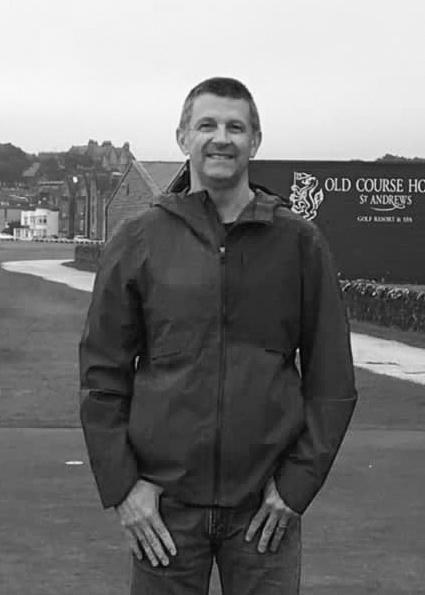| story by | |
| photos by | Steven Hertzog |
| OPEN A PDF OF THE ARTICLE |
The many facets of mathematics come together to not only solve simple day-to-day calculations but also enhance overall creative problem-solving and critical thinking.
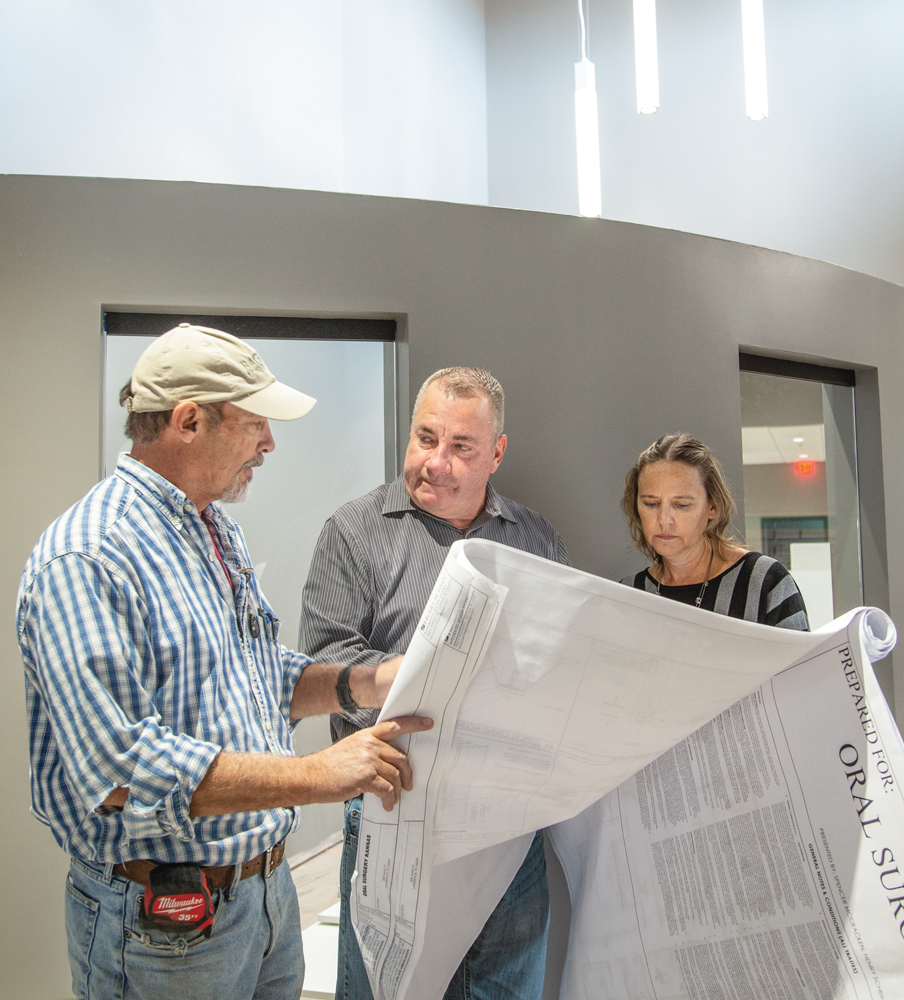
Paul Werner (center) with associate Leticia Cole of Paul Werner Architecture and Mark Green of BA Green going over the plans for the new offices of Oral Surgery Kansas
Paul Werner is a self-described math geek. Alex Karam earned a master’s degree in mathematics and taught college math. Today, they work as architect and engineer, respectively. Werner is owner of Paul Werner Architects, in downtown Lawrence, which, in collaboration with Gould Evans, had hands in designing and creating everything from Sports Pavilion Lawrence and Rock Chalk Park to renovating popular local spots like Lawrence Beer Co. and Bon Bon!, as well as high-end custom homes. Karam is a partner with Latimer Sommers & Associates, an engineering consulting firm with a focus on mechanical, electrical, plumbing and telecommunication design with offices in Topeka and Overland Park.
Both have enjoyed longstanding love affairs with mathematics and math principles that have served them well—and continue to be of use—in their chosen fields. Whether it’s the simpler side of measuring dimensions in planning construction of a building, the geometry involved in calculating the angle of the pitch of a roof, something more complicated such as figuring ratios of various weights and supports for load-management purposes or even keeping expenses and income straight when dealing with the company books, math and its myriad applications play major roles in being a successful architect or engineer.
LOCAL MATTERS
Our Local Advertisers – Making a Positive Impact
Same goes for local firms like Bartlett & West, a full-service engineering company with branch offices throughout the country, or Hoke Ley Architecture & Design, a multidisciplinary architecture firm in east Lawrence that is involved in luxury residential and commercial projects around the U.S. When it comes to most of their day-to-day work procedures, rest assured the application of mathematics principles are in the consciousness. Even the subconsciousness.
“All the stuff we do is technical in nature,” Werner says. “Even though most of what we do is on computers, you still have to have an understanding of it. Even if you run a computer program, you still have to put in the right information.
“We probably use math even more than we think we are,” he adds.
As Karam says, most of what any kind of engineer—electrical, mechanical, plumbing, civic, environmental—does in their day-to-day work involves formulas. All those formulas involve math.
“Every day, we use math in our calculations,” he says. “Some are simpler, like coming up with total tonnage for a building. Others are more complicated. Some we establish our own rules of thumb and use our experience.
“It’s all based on mathematics and mathematical equations you’ve got to plug in if you want to get the result you want,” Karam explains.
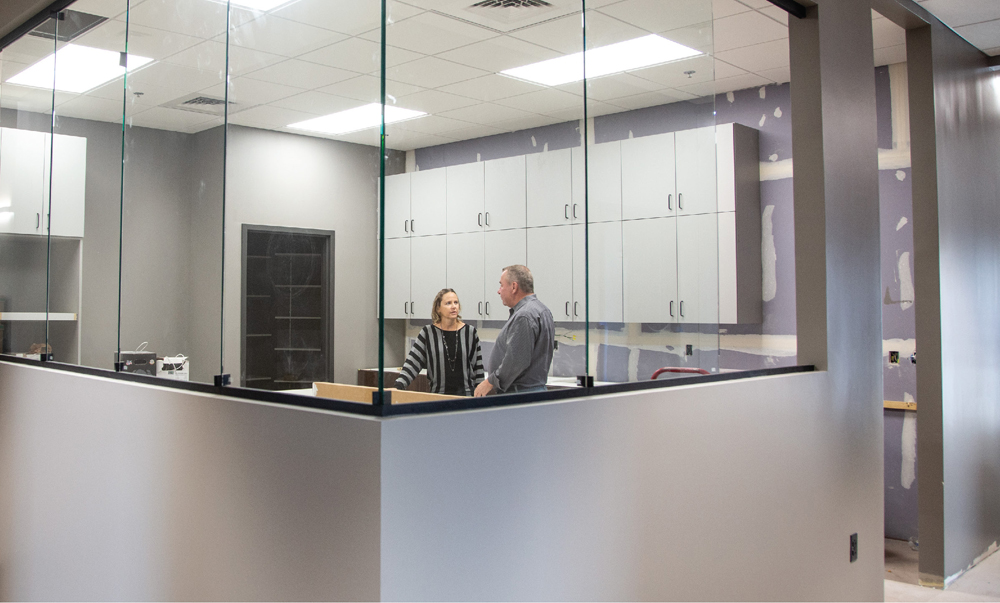
Paul Werner and Leticia Cole stand inside the centralized sterilization and lab space which has a corner of glass for visibility and connection between the two pods of treatment rooms at the new home of Oral Surgery Kansas
Math’s Use in Critical Thinking
Werner, who oversees a staff of nine in his offices in the lower level of a historic building on Eighth Street, remembers sitting in his college calculus classes and being enthralled—and not simply with the numbers and symbols on a blackboard or piece of paper.
“I think calculus is as much about how to solve problems as much as actual math,” says Werner, who holds degrees in both architecture and architectural engineering. “Just the idea that you have limits at both ends of a problem, and you have to figure out the right answer that fits between those two limits … . That always interested me.”
It’s also served Paul Werner Architects well as it’s gone about designing commercial and residential projects, site planning, zoning, analyzing building code and urban planning. One of the firm’s most visible projects in recent months is the new construction of a building for Oral Surgery Kansas at Sixth Street and Monterey Way.
He points out that much of the math involves simple business calculations centered around costs of construction and interest rates—basically, how much a project will cost to complete.
“We do a lot of work for developers and financing comes into it,” he explains. “Whether a project can make money.”
Geometry comes into play on something like the pitches of roofs. Many roofs are built on what is commonly called 6 by 12: 6 inches in rise for every 12 inches it goes out. Calculations are commonly made on where to place exit doors on a building to meet city building codes.
All these calculations are made via computer programs, but as Werner says, it’s always good to hold that basic math knowledge close, for the critical thinking aspect if nothing else.
“I’ve tried to stay on top of technology,” he says. “It’s all good. The more you can learn, the better you are.”
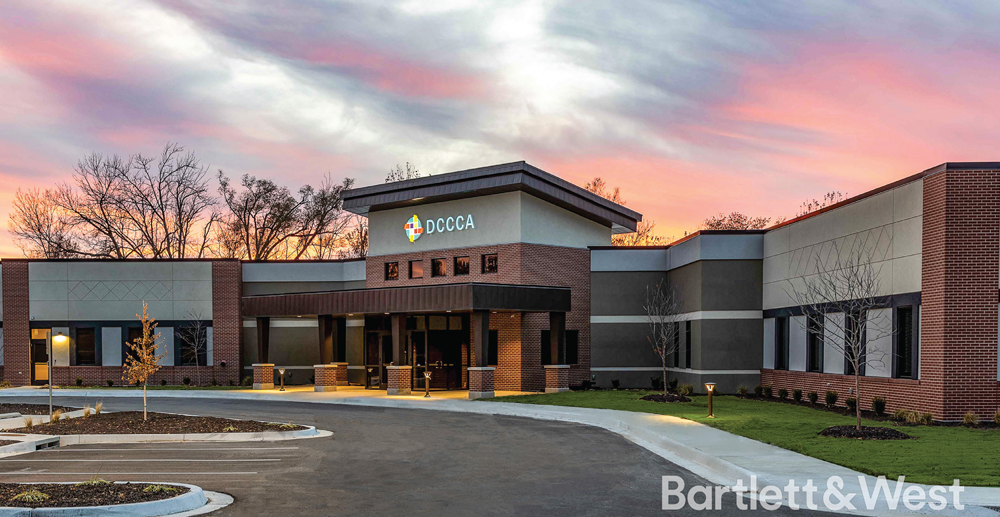
“]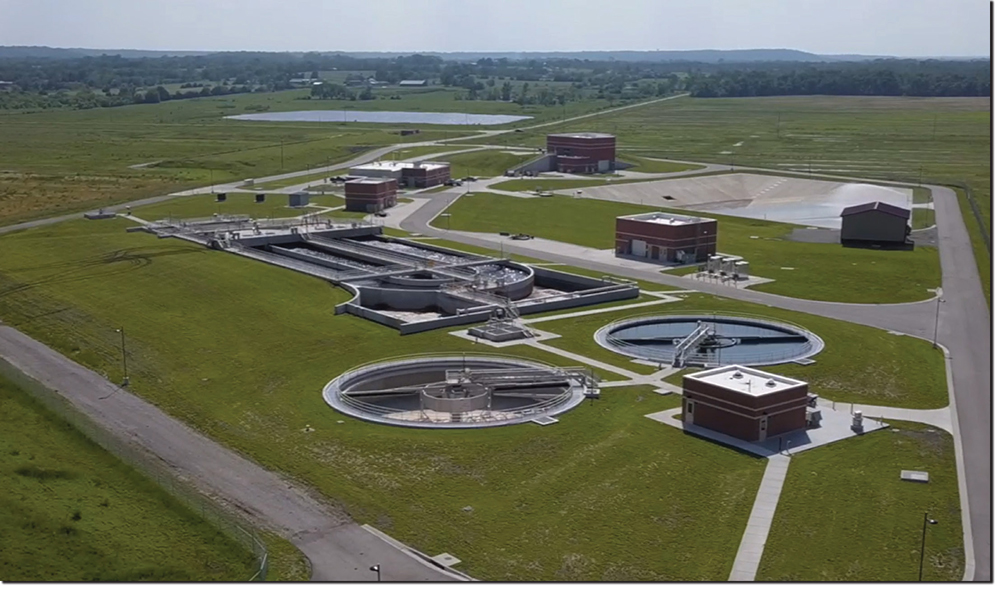 Bartlett & West engineered the new DCCCA building and the Wakarusa Wastewater Treatment Facility in Lawrence, Ks
Bartlett & West engineered the new DCCCA building and the Wakarusa Wastewater Treatment Facility in Lawrence, Ks
Using Math in Estimations
Joe Caldwell started his career at Bartlett & West 30 years ago as a project engineer. Today, he’s the company’s chief executive officer and leads a company that is 100 percent owned by its 430 employees who serve customers in seven states. According to its website, Bartlett & West is an engineering firm offering deep industry knowledge and creative problem-solving skills to help plan, design and build projects … leveraging technology to solve problems and deliver innovative solutions to meet client needs, whether it be construction and survey, environmental planning, landscape architecture, storm and wastewater, or site development.
And all that seems to have one thing in common.
“As you go into the design world, there’s a lot of math involved in everything you do,” Caldwell says. “Geometry, trigonometry … . Figuring out volumes of things.
“It can get really precise,” he continues. “But a lot of times, we don’t have details, so we’re using judgments to make estimations. A lot of the numbers are very precise, but you also have to be able to estimate and understand if those estimates make sense. And you have to use math in those estimations.”
Caldwell uses hydrology, calculations used in controlling stormwater, as an example.
“Sometimes it’s as much of an art as it is a science,” he says. “None of it is perfect. There’s a lot of feel in it.
“When you think about a building or bridge, it’s very precise,” Caldwell adds. “But there are a lot of other critical-thinking pieces, a lot of judgment. Being able to visualize what the outcome is [is]important to a great design. You have to have common sense.”
Road design, in which designers must calculate pitch to allow for proper storm drainage, is another area where geometry and other mathematical calculations come into play, he says. Design criteria guidelines vary depending on the area and landscape. Slopes and cross slopes must be factored in to ensure there’s at least a 1 percent grade so that water runs off.
Wastewater engineers have to mathematically calculate what is referred to as “biology loading,” which is determining how much volume of chemicals is used to properly treat wastewater.
And then, there’s the business of engineering. Caldwell uses the Kansas Department of Transportation as an example. The department is very particular about the quantity of products used on its projects, he says. Various project models must be modified or manipulated to fit the department’s “bid list.”
“There’s a lot of scoping work involved,” he explains. “You have to show the client the scope and how the fee was calculated.
“The goal is to help the company be successful with the job while also making the client happy,” Caldwell says.
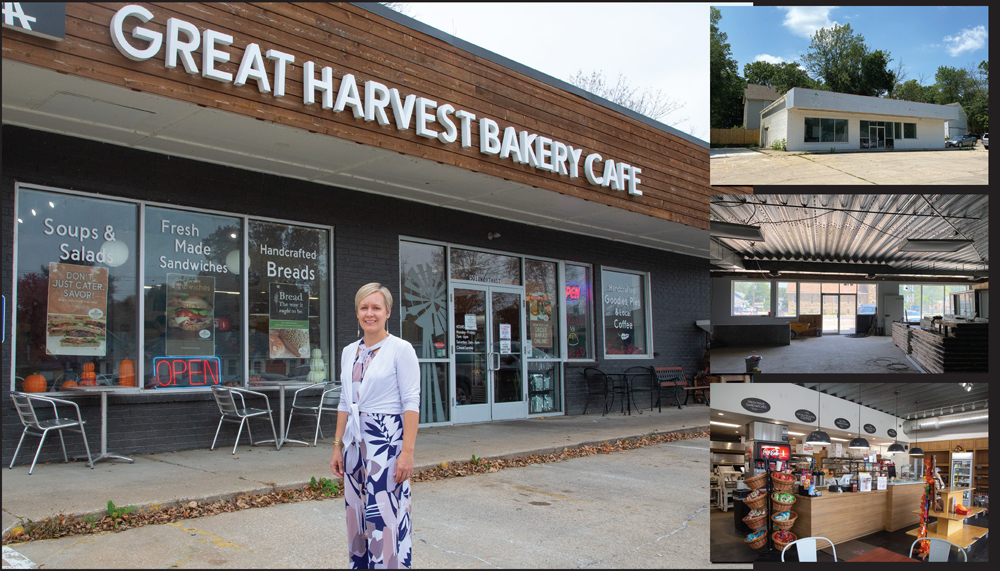
Katie Hoke (standing outside) and Caleb Amundson, of Hoke Ley Architects led the design and reimagining of the new Great Harvest Bread Bakery and Cafe. Working with the client’s modest budget and existing building features, they were able to transform an un-inspiring vacant building into a vibrant cafe for the community.; Working with the existing flooring and ceiling, they used warm natural materials to create a welcoming customer experience. Hoke Ley worked closely with the owner to create the custom kitchen layout.
“Woven Into How We Work”
While Hoke Ley is small in its workforce—only five employees—it’s mighty in its architectural footprint throughout the Lawrence area and beyond. There have been renovations to structures that house Stephens Real Estate, Great Harvest Bread Co. and Encore Cafe, along with a number of private residences. But there also are Hoke Ley projects in the Pacific Palisades in the Los Angeles area, luxury homes in Scottsdale, Arizona, and commercial projects in Nebraska, as well as those in the Kansas City and St. Joseph, Missouri, areas.
Those projects, and nearly everything else Hoke Ley is involved in, have involved math.
“It’s completely woven into how we work,” says Katie Hoke, principal, owner. Everything is ratios and proportions. Everything we do is numbers-based, whether it’s laying out square footage, spacing, how you work out measurements in feet and inches.”
Hoke says her company works in even increments when planning building foundations. Framing is done in what she calls “2-4-6-8 modules” when possible, ensuring that pieces of plywood fit perfectly next to one another. On the interiors of buildings, the layout of floor and wall tiles must be calculated carefully to properly fit the space so there isn’t a need for a sliver of tile in the end. There also are area-volume calculations that are constantly being made … if a volume of earth is being displaced, what is it being replaced with?
“We’re focused a lot on the human scale of spaces,” she says. “That all comes down to proportions of space. We know from experience what proportions work, but it’s also scale.
“A lot of design is rooted in math. None of us are real experts at math,” Hoke continues. “We just know how to apply it to what we’re working on.”
She agrees wholeheartedly that much of the value of having knowledge in mathematics lies in the exercise of problem-solving and critical thinking.
“I have a daughter who’s a (high school) freshman taking algebra, and she asked me, ‘Why would I use this?’ ” Hoke says. “I told her you need to learn to exercise the brain, know how to break the rules. It’s the iterative process of breaking down the process of solving a problem. That’s very important.
“You don’t ever want to get lucky,” she adds. “You want to know exactly how we got to the end point. And then, when you get the right answer, you want to get to it more quickly the next time.
“You don’t have to be a math genius. You just have to embrace it and have an understanding of how to use it,” Hoke says.
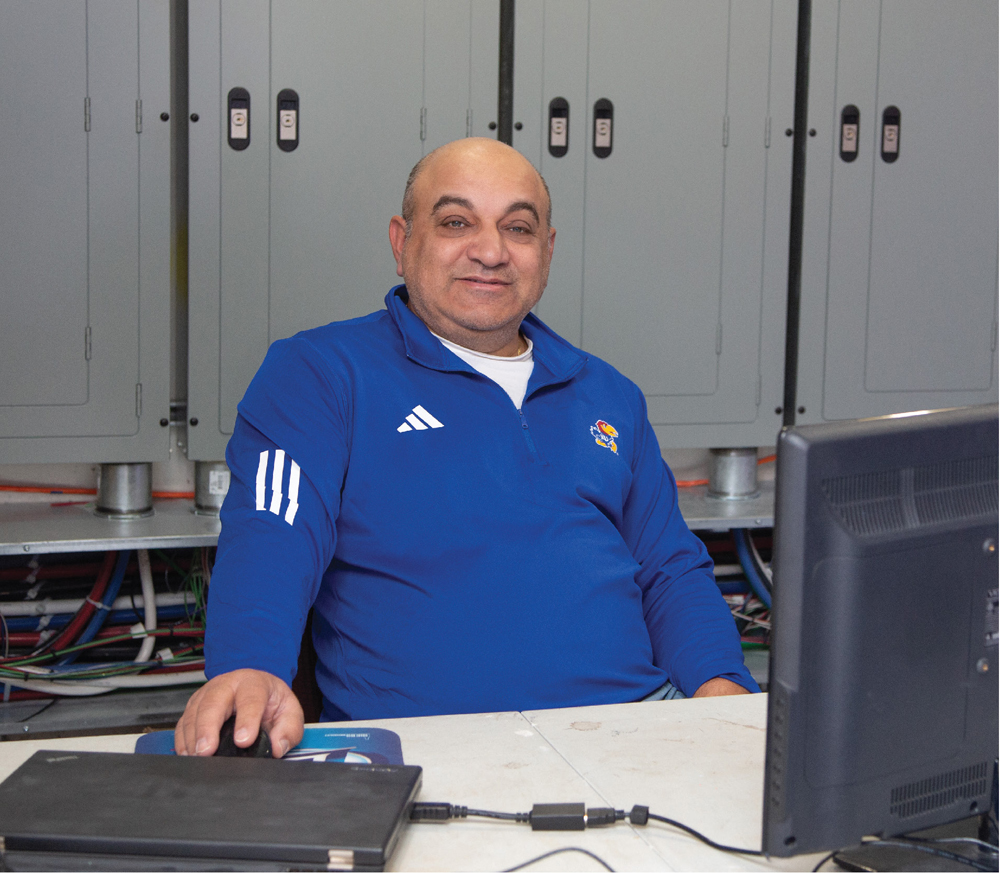
Alex Karam, partner and engineer for Latimer, Sommers & Associates an engineering consulting firm with a focus on mechanical, electrical, plumbing and telecommunication design
Math and Formulas
Karam started in 1999 as an engineer in training and became licensed and a partner in 2007 at Latimer Sommers & Associates, which has been around more than 65 years, services a minimum of 15 states per year and designs systems that average more than $500 million in construction costs each year. He says the firm currently has projects ongoing in Florida, Mississippi, Missouri and Oklahoma.
Most successful engineering comes down to one thing, he explains, having workable formulas and knowing how to use them. And there’s a certain knowledge required in working through these formulas.
“In engineering, whatever we do, there are formulas we use,” Karam says. “Those are all mathematics. Without it, we cannot get to the answers we need.”
He says engineering uses the Psychrometric Chart to calculate building load for HVAC units. From sensible load, latent load, humidification load, cooling load, etc. … these energy calculations are all based on mathematical formulas where values must be plugged in and obtained from the Psychrometric Chart to find a final value.
Like most engineers or architects who work with math in today’s technological age, the answers to formulas or problems are as easy and as close as a button on a computer. But that doesn’t appear to be good enough for an old engineering hand like Karam.
“As a young engineer, I did (calculations) by hand,” he says. “I wanted to know what all the numbers mean. Doing calculations by hand for so many years gave me the ability to come up with my own rule of thumb for different types of buildings’ HVAC load.
“Today’s engineers rely more and more on computer values, not knowing if these values make sense or not,” Karam continues. “Computers utilize input parameters and figures to produce output results. While computers are very useful, engineers should also know the equations and math that the computer software uses to calculate the results, to help us determine what parameters are most important and improve our design accordingly.”
That’s why Karam didn’t stop his education with a bachelor’s degree in engineering that required extensive math knowledge and earned his master’s in the very discipline he knew he’d use the rest of his professional career.
“This way, I had both sides of it,” he says. “That served me well.”


